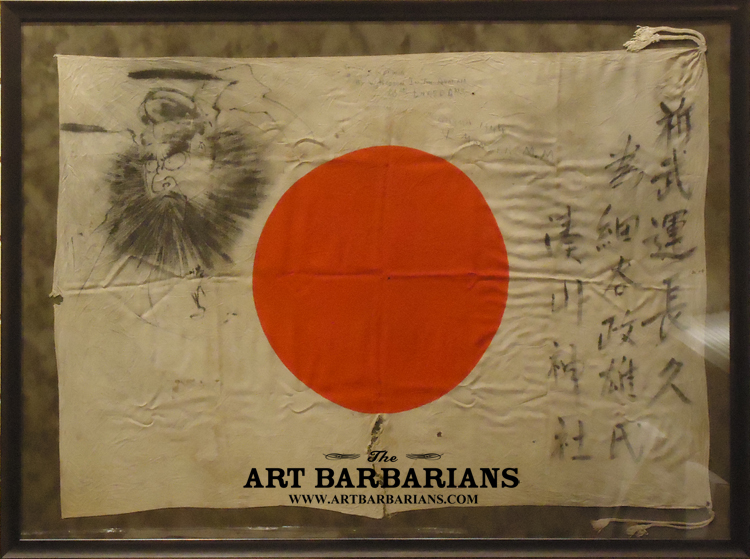Home | Prints | Originals | Framed Art | Framing | Events | About Us | Mailing List | Map | View Cart

Type in keywords, titles, portions of titles, artist name or combinations of any to search our entire site.
First Picture | Previous Picture | Next Picture | Last Picture

Framed Japanese Imperial Landing Force Flag
By Custom Framing Examples
Framed Japanese Imperial Landing Force Flag.
You name it we frame it! A customer brought in this flag for us to frame. It flew over the Headquarters of the Japanese Imperial Landing Force in Burma until the British liberated Burma. It is signed by two high ranking British officers.
Japanese objectives in Burma were initially limited to the capture of Rangoon (now known as "Yangon"), the capital and principal seaport. This would close the overland supply line to China and provide a strategic bulwark to defend Japanese gains in British Malaya and the Dutch East Indies. The Japanese Fifteenth Army under Lieutenant General Shōjirō Iida, initially consisting of only two infantry divisions, moved into northern Thailand (which had signed a treaty of friendship with Japan), and launched an attack over jungle-clad mountain ranges into the southern Burmese province of Tenasserim (now Tanintharyi Region) in January 1942.
The Japanese successfully attacked over the Kawkareik Pass, and captured the port of Moulmein at the mouth of the Salween River after overcoming stiff resistance. They then advanced northwards, outflanking successive British defensive positions. Troops of the 17th Indian Infantry Division tried to retreat over the Sittaung River, but Japanese parties reached the vital bridge before they did. On 22 February, the bridge was demolished to prevent its capture, a decision that has since been extremely contentious. The loss of two brigades of 17th Indian Division meant that Rangoon could not be defended. General Archibald Wavell, the commander-in-chief of the American-British-Dutch-Australian Command, nevertheless ordered Rangoon to be held as he was expecting substantial reinforcements from the Middle East. Although some units arrived, counterattacks failed and the new commander of Burma Army (General Harold Alexander), ordered the city to be evacuated on 7 March after its port and oil refinery had been destroyed. The remnants of Burma Army broke out to the north, narrowly escaping encirclement. On the eastern part of the front, in the Battle of Yunnan-Burma Road, the Chinese 200th Division held up the Japanese for a time around Toungoo, but after its fall the road was open for motorized troops of the Japanese 56th Division to shatter the Chinese Sixth Army to the east in the Karenni States and advance northward through the Shan States to capture Lashio, outflanking the Allied defensive lines and cutting off the Chinese armies from Yunnan. With the effective collapse of the entire defensive line, there was little choice left other than an overland retreat to India or to Yunnan.
| Types | Dimensions | Edition Size | Price | Cart |
|---|---|---|---|---|
| Not for sale just a framing example | Please Inquire | Click to Inquire |
To Order Call:
763-494-8888